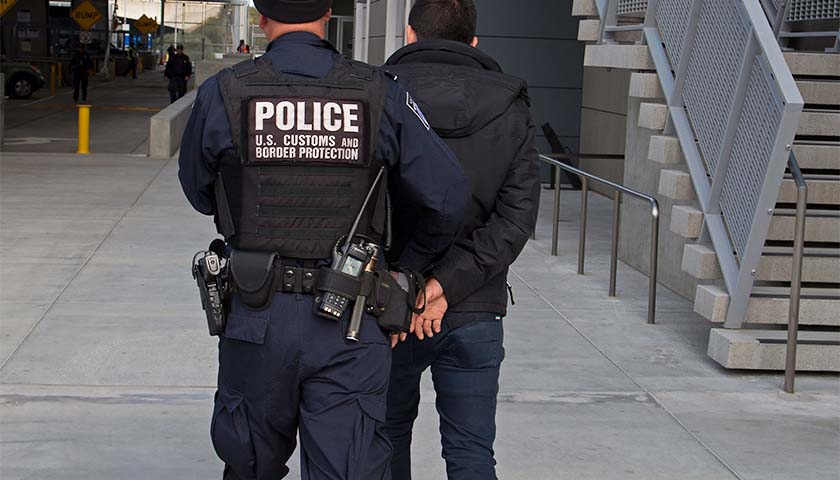by Jason Richwine
When Joe Biden chose to revoke the Trump Administration’s border rules, he sparked an unprecedented crisis at the southern border. The illegal immigrant population has already risen by 2 million since Biden’s inauguration, and the flow has not stopped. Some of the consequences of this crisis are indisputable—a strain on border communities, a fiscal burden for taxpayers, and a weakening of the rule of law.
Another important consequence, although fraught with controversy, is a potential increase in violent crime. Despite advocates’ repeated insistence that illegal immigrants do not threaten public safety, the evidence is not so clear. In fact, some data out of Texas suggest that illegal immigrants are convicted of homicide and sexual assault at higher rates than the state average.
In thinking about illegal immigrant criminality, it is important to distinguish the number of crimes from the rate of crime. There is no question that illegal immigrants have committed a large number of crimes in border states such as Texas. The state’s Department of Public Safety (DPS) reports that hundreds of thousands of illegal immigrants have been arrested in Texas on all manner of charges, including 986 homicide charges dating back to 2011.
These numbers are damning enough for some opponents of illegal immigration. From their perspective, the only acceptable number of illegal immigrant crimes is zero, since illegal immigrants should not be here in the first place. If we want to know the impact of illegal immigration specifically on public safety, however, we need to consider the rate at which illegal immigrants commit crime. After all, a town with 10,000 people and three murders is clearly safer than a town with 1,000 people and two murders, even though the latter has fewer total murders.
Activists argue that illegal immigrants have below-average rates of crime. Their exhibit A is Texas, where DPS collects and distributes some of the best data on the immigration status of arrestees and convicts. These researchers added up the number of crime convictions of people who were identified as illegal upon arrest, divided by the estimated population of illegals in the state, and found a conviction rate that was lower than the state average. Therefore, they concluded, illegal immigration actually makes Texas safer.
That conclusion is dubious. A recent report I co-authored for the Center for Immigration Studies shows that prior studies misclassified many illegals as natives or legal immigrants, thus understating the illegal immigrant crime rate. The mistake occurred because not all illegal immigrants are immediately identified as such when they are arrested. Some are later identified in prison, while others may never have their status discovered if they are released without sufficient time for an investigation.
When my co-authors and I re-ran the numbers to include both illegals identified at arrest and illegals identified in prison, we found that illegal immigrants in Texas appeared to have above-average conviction rates for serious crimes such as homicide, sexual assault, and kidnapping. To illustrate, the number of homicide convictions per 100,000 among illegal immigrants was 3.4 in 2017, compared to 2.9 for the overall Texas population. The disparity in sexual assault convictions per 100,000 was even more stark—19.4 among illegal immigrants versus just 9.5 for the state overall.
There are several caveats. First, the DPS classifications remain incomplete and subject to revision. Second, although we used the most widely-accepted estimates of the total illegal population in Texas, the actual number is unknown. (Underestimating the total illegal alien population would cause an overstatement of their crime rate.)
Furthermore, illegal immigrants in the DPS data seem to have below-average conviction rates for robbery, drugs, and a host of lesser offenses. If we naively add up illegal immigrant convictions for all crimes, we find an overall lower rate than the state average. As mentioned above, however, not all illegals are identified upon arrest or even while in prison. Key determinants of whether illegals will be identified in prison are the seriousness of their offense and their length of stay. So while authorities have extensive time and incentive to investigate the immigration status of convicted murderers and rapists, they are less likely to investigate the status of people convicted of simple assault or theft.
To summarize, we know little about the overall crime rate of illegal immigrants in Texas, except that it is probably understated in the DPS data. There is stronger evidence that illegal immigrants are convicted of serious offenses such as homicide and sexual assault at above-average rates, but more research is needed.
In the meantime, blanket statements that illegal immigrants make their communities safer are unwarranted. Americans are right to be concerned about the impact of illegal immigration on crime. Their concern is yet another reason to secure the border as quickly as possible.
– – –
Jason Richwine is a resident scholar at the Center for Immigration Studies.
Photo “U.S. Customs and Border Protection Officer Escorts a Detainee to a Processing Area” by U.S. Customs and Border Protection.






And keep in mind….the same people that are encouraging these violations of our national borders, that would be the democrats and the UN, want to completely take away our ability to defend ourselves from these violent third worlders. It just goes to show the ignorance of the leftest sheeple.